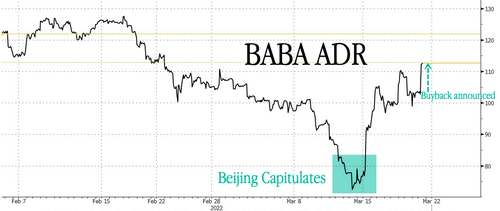Alibaba Soars As Buyback Program Upsized Adds Euphoria To Chinese ADRs
Nearly a week after China’s top financial policy body vowed to ensure stability in equity markets and support oversea stock listings, more fuel was added to the rally on Tuesday when Alibaba Group upsized its share buyback program to $25 billion from $15 billion, sending Alibaba shares in Hong Kong as much as 5.4% higher. The move indicates a multi-year crackdown on technology companies by Beijing is waning.
Shares of Chinese-listed stocks in the US were lifted as well. Alibaba jumped 8.9%, Baidu +4.8%, JD.com +5.5%, Pinduoduo +5.9%, ride-hailing giant Didi +5.8%.
Today’s news builds on last week’s intervention to save crashing Chinese technology stocks by Yi Gang, governor of the People’s Bank of China, who said measures were being taken to study the implementation of the State Council’s promises, including keeping the capital market stable.
The Chinese government may have forced the end of capitulation after Chinese stocks suffered more than a year of losses. Sentiment has reversed into euphoria for the second week. Usually, intervention like this produces a bottom, but that remains in question.
Coursey of Bloomberg, here’s what Wall Street analysts are saying about Alibaba’s upsize buyback program:
Kamet Capital Partners (Kerry Goh)
In the current climate, this is a good move toward focusing on shareholder return and better use of cash
The likes of Alibaba, Tencent should be doing more of these buybacks
“The Chinese generally believe you shouldn’t waste the bullet when the tide is against you. Could this be a signal that the management believes the worst is behind them especially since Liu He’s announcement last week?”
Goh said the firm increased its holdings of Alibaba’s Hong Kong-listed shares last week and will likely add to positions following the upsized buyback news
CMC Markets Singapore (Kelvin Wong)
The news is likely to provide “some stabilization and relief” to Alibaba’s major downtrend in place since October 2020, and extend its recent rally
Its China Big Tech peers may use excess cash reserves to invest in other international markets or fixed investments that are skewed towards overseas revenue generation, given that the domestic market is more regulated in the past year
United First Partners (Justin Tang)
It signals where the management sees value
“It may also be a bellwether for where they see regulatory action – perhaps we are coming closer to the end of it”
DailyFX (Margaret Yang)
This marks one of the largest share buyback programs in China’s technology industry, and thus may set a good example for other tech giants which have sufficient cash flow to warrant buybacks
The increase in share buyback reflects the company’s confidence in its long-term growth and it may also help to bolster investor confidence after a prolonged period of selloff
In any case, a heavy-handed approach to managing market swings is never a sure thing, like it did for Beijing after a stock bubble burst in 2015, when botched interventions helped accelerate selling. The CSI 300 didn’t recover its 2015 high until five years later.
Some, like Sean Debow, CEO of Eurizon Capital Asia, recently warned, “I do not believe this is a turning point — we are in a very turbulent period.”
“In order to catch a falling knife you have to have very very strong conviction, and we don’t have that yet,” Debow said.
In other words, Beijing would have to unleash a massive credit impulse upturn for China to see a sustainable stock bounce. However, so far authorities – still concerned about the size of Chna’s epic debt bubble – appear content to limit intervention primarily to expansive jawboning coupled with modest intervention.
Tyler Durden
Tue, 03/22/2022 – 07:32

